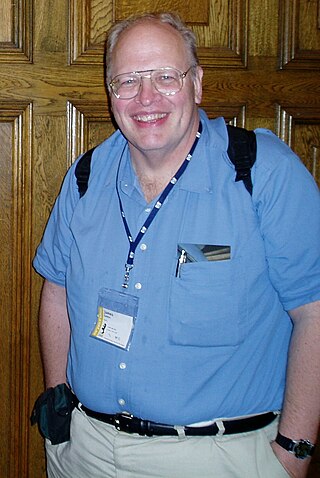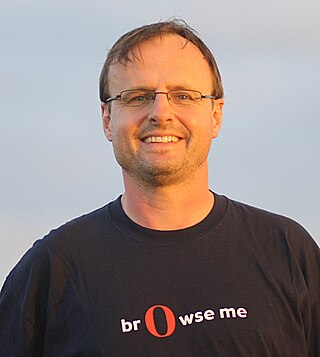
Hypertext Markup Language (HTML) is the standard markup language for documents designed to be displayed in a web browser. It defines the content and structure of web content. It is often assisted by technologies such as Cascading Style Sheets (CSS) and scripting languages such as JavaScript, a programming language.
An HTML editor is a program used for editing HTML, the markup of a web page. Although the HTML markup in a web page can be controlled with any text editor, specialized HTML editors can offer convenience, added functionality, and organisation. For example, many HTML editors handle not only HTML, but also related technologies such as CSS, XML and JavaScript or ECMAScript. In some cases they also manage communication with remote web servers via FTP and WebDAV, and version control systems such as Subversion or Git. Many word processing, graphic design and page layout programs that are not dedicated to web design, such as Microsoft Word or Quark XPress, also have the ability to function as HTML editors.

Amaya is a discontinued free and open source WYSIWYG web authoring tool with browsing abilities.

Jim Gettys is an American computer programmer.

Håkon Wium Lie is a Norwegian web pioneer, a standards activist, and the chairman of YesLogic, developers of Prince CSS-based PDF rendering software. He is best known for developing Cascading Style Sheets (CSS) while working with Tim Berners-Lee and Robert Cailliau at CERN in 1994. He was the chief technology officer of Opera Software from 1998 until the browser was sold to new owners in 2016.
A testbed is a platform for conducting rigorous, transparent, and replicable testing of scientific theories, computing tools, and new technologies.

The Line Mode Browser is the second web browser ever created. The browser was the first demonstrated to be portable to several different operating systems. Operated from a simple command-line interface, it could be widely used on many computers and computer terminals throughout the Internet. The browser was developed starting in 1990, and then supported by the World Wide Web Consortium (W3C) as an example and test application for the libwww library.

HTTP pipelining is a feature of HTTP/1.1, which allows multiple HTTP requests to be sent over a single TCP connection without waiting for the corresponding responses. HTTP/1.1 requires servers to respond to pipelined requests correctly, with non-pipelined but valid responses even if server does not support HTTP pipelining. Despite this requirement, many legacy HTTP/1.1 servers do not support pipelining correctly, forcing most HTTP clients to not use HTTP pipelining.
JavaScript Style Sheets (JSSS) was a stylesheet language technology proposed by Netscape Communications in 1996 to provide facilities for defining the presentation of webpages. It was an alternative to the Cascading Style Sheets (CSS) technology.

Acid2 is a webpage that test web browsers' functionality in displaying aspects of HTML markup, CSS 2.1 styling, PNG images, and data URIs. The test page was released on 13 April 2005 by the Web Standards Project. The Acid2 test page will be displayed correctly in any application that follows the World Wide Web Consortium and Internet Engineering Task Force specifications for these technologies. These specifications are known as web standards because they describe how technologies used on the web are expected to function.

Chris Lilley is a British computer scientist known for co-authoring the Portable Network Graphics (PNG) format, starting the Scalable Vector Graphics (SVG) format, and his work on HTML2, CSS2, and Web fonts.

Libwww is an early World Wide Web software library providing core functions for web browsers, implementing HTML, HTTP, and other technologies. Tim Berners-Lee, at the European Organization for Nuclear Research (CERN), released libwww in late 1992, comprising reusable code from the first browsers.
Henrik Frystyk Nielsen is a Danish engineer and computer scientist. He is best known for his pioneering work on the World Wide Web and subsequent work on computer network protocols.

Cascading Style Sheets (CSS) is a style sheet language used for specifying the presentation and styling of a document written in a markup language such as HTML or XML. CSS is a cornerstone technology of the World Wide Web, alongside HTML and JavaScript.

CERN httpd is an early, now discontinued, web server (HTTP) daemon originally developed at CERN from 1990 onwards by Tim Berners-Lee, Ari Luotonen and Henrik Frystyk Nielsen. Implemented in C, it was the first web server software.

In web development, the CSS box model refers to how HTML elements are modeled in browser engines and how the dimensions of those HTML elements are derived from CSS properties. It is a fundamental concept for the composition of HTML webpages. The guidelines of the box model are described by web standards World Wide Web Consortium (W3C) specifically the CSS Working Group. For much of the late-1990s and early 2000s there had been non-standard compliant implementations of the box model in mainstream browsers. With the advent of CSS2 in 1998, which introduced the box-sizing property, the problem had mostly been resolved.

Dave Raggett is an English computer specialist who has played a major role in implementing the World Wide Web since 1992. He has been a W3C Fellow at the World Wide Web Consortium since 1995 and worked on many of the key web protocols, including HTTP, HTML, XHTML, MathML, XForms, and VoiceXML. Raggett also wrote HTML Tidy and is currently pioneering W3C's work on the Web of Things. He lives in the west of England.
Agora was a World Wide Web email browser that served as a proof of concept to help people use the full internet. Agora was an email-based web browser designed for non-graphic terminals and to help people without full access to the internet such as in developing countries or without a permanent internet connection. Similar to W3Gate, Agora was a server application designed to fetch HTML documents through e-mail rather than http.
Argo was part of a project to make the Internet accessible to scholars in the Humanities at the University of Groningen. The Argo web browser was created in August 1994 by Bert Bos.
Media queries is a feature of CSS 3 allowing content rendering to adapt to different conditions such as screen resolution. It became a W3C recommended standard in June 2012, and is a cornerstone technology of responsive web design (RWD).




















